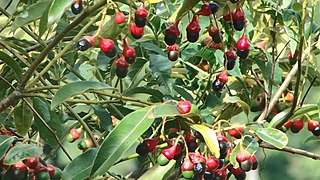
The macaques constitute a genus (Macaca) of gregarious Old World monkeys of the subfamily Cercopithecinae. The 23 species of macaques inhabit ranges throughout Asia, North Africa, and Europe. Macaques are principally frugivorous, although their diet also includes seeds, leaves, flowers, and tree bark. Some species such as the long-tailed macaque will supplement their diets with small amounts of meat from shellfish, insects, and small mammals. On average, a southern pig-tailed macaque in Malaysia eats about 70 large rats each year. All macaque social groups are arranged around dominant matriarchs.

Lauraceae, or the laurels, is a plant family that includes the true laurel and its closest relatives. This family comprises about 2850 known species in about 45 genera worldwide. They are dicotyledons, and occur mainly in warm temperate and tropical regions, especially Southeast Asia and South America. Many are aromatic evergreen trees or shrubs, but some, such as Sassafras, are deciduous, or include both deciduous and evergreen trees and shrubs, especially in tropical and temperate climates. The genus Cassytha is unique in the Lauraceae in that its members are parasitic vines. Most laurels are highly poisonous.

The guenons are Old World monkeys of the genus Cercopithecus. Not all members of this genus have the word "guenon" in their common names; also, because of changes in scientific classification, some monkeys in other genera may have common names that include the word "guenon". Nonetheless, the use of the term guenon for monkeys of this genus is widely accepted.

Ocotea is a genus of flowering plants belonging to the family Lauraceae. Many are evergreen trees with lauroid leaves.

Aristeguietia glutinosa is a species of flowering plant in the family Asteraceae. It is found only in Ecuador, where it is commonly called matico. In Peru, that name refers to the unrelated Piper aduncum, in Chile and Argentina the name matico is used for Buddleja globosa.

Ocotea aciphylla is a species of Ocotea in the plant family Lauraceae. It forms a tree 12–18 m tall. It has small hermaphrodite flowers of 3–4 mm long. It is found in the Amazon river basin mostly to 1200 m.

Ocotea basicordatifolia is a species of Ocotea in the plant family Lauraceae.

Ocotea catharinensis is a member of the plant family Lauraceae. It is a slow-growing evergreen, a valuable hardwood tree of broad ecological importance, and it is threatened by habitat loss and by overexploitation for its timber and essential oils.

Ocotea cymbarum is a species of Ocotea in the plant family Lauraceae. It is an evergreen tree found in Brazil, Colombia, French Guiana, Guyana, Suriname, and Venezuela.

Ocotea foetens, commonly called til or stinkwood is a species of tree in the family Lauraceae. It is evergreen and grows up to 40 m tall. It is a common constituent of the laurisilva forests of Madeira and the Canary Islands. Leaf fossils of this species are known from the Mio-Pleistocene of Madeira Island.

Ocotea gabonensis is a species of plant in the family Lauraceae.

Ocotea kenyensis is a species of plant in the family Lauraceae. It is found in the Democratic Republic of the Congo, Eswatini, Ethiopia, Kenya, Malawi, Mozambique, Rwanda, South Africa, Sudan, Tanzania, Uganda, and Zimbabwe. It is threatened by habitat loss.
Ocotea otuzcensis is a species of tree in the family Lauraceae. It is endemic to Peru and considered as a vulnerable species by the IUCN.

Ocotea porosa, commonly called imbuia or Brazilian walnut, is a species of plant in the Lauraceae family. Its wood is very hard, and it is a major commercial timber species in Brazil.

Ocotea odorifera is a species of plant in the family Lauraceae. It is an evergreen tree in the genus Ocotea.

Ocotea puberula is a species of evergreen tree in the plant genus Ocotea of the family Lauraceae. It is found in Argentina, Brazil, French Guiana, Guyana, Mexico, Peru, and Suriname.
Ocotea rotundata is a species of evergreen tree in the genus of plants Ocotea, in the family Lauraceae. It is endemic to Ecuador. Its natural habitat is subtropical or tropical moist montane forests.
Maytenus umbellata is a species of plant in the family Celastraceae. Common names include Buxo-da-rocha and Madeira shrubby bittersweet. It is endemic to Madeira.
Kuloa ikonyokpe is a species of tree in the laurel family (Lauraceae). It is endemic to Cameroon.















